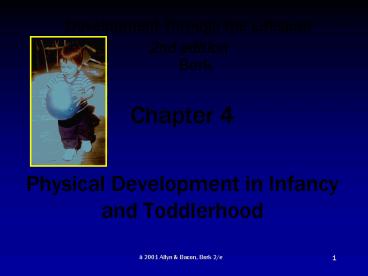Chapter 4 Physical Development in Infancy and Toddlerhood PowerPoint PPT Presentation
1 / 21
Title: Chapter 4 Physical Development in Infancy and Toddlerhood
1
Chapter 4Physical Development in Infancy and
Toddlerhood
- Development Through the Lifespan
- 2nd edition Berk
2
BODY GROWTH
- Changes in Body Size and Muscle Fat
- (0 to 2 years)
- Physical growth is rapid.
- Length increases 50 percent by first year, 75
percent by second. - Weight doubles at 5 months, triples by first
year, and quadruples by the second. - Gains occur in growth spurts.
- Early rise in baby fat until 9 months
- Helps keep a constant body temperature
- Toddlers become more slender.
3
Individual and Group Differences
- Skeletal age
- Measure of bone development
- Best way to measure physical development
- Girls are slightly shorter and lighter and have a
higher ratio of fat to muscle. - Ethnic differences in size and rate of growth
- Developmental problems and mortality rates vary
by gender and race.
Figure 4.1
4
BRAIN DEVELOPMENT
Birth
- Neurons
- At birth, the brain is nearer its adult size than
any other physical structure. - 100 to 200 billion neurons
- Synapses
- Tiny gaps between neurons
- Neurons release chemicals that send messages
- Synaptic pruning
- Unused neurons die off.
- Myelinization
- Neural fibers are coated with fatty insulation.
- Glial cells myelinate.
Six months
Two years
Figure 4.3
5
The Cerebral Cortex
- 85 percent of brain weight, and last to stop
growing - Different regions have specific functions.
- Frontal lobes (thought) develop later.
- Lateralization
- Specialization of hemispheres in cortex
- Brain plasticity
- Ability of part of brain to take over function of
damaged part
Figure 4.4
6
Sensitive Periods of Development
- Stimulation is vital during growth spurts, which
occur from infancy to early adulthood. - Experience "wires" a child's brain growth.
- Understimulation impairs development.
- Possible to overwhelm children
- Note new brain research
7
INFLUENCES ON PHYSICAL GROWTH
- Heredity largely determines height and rate of
physical growth. - Catch-up growth
- Heredity and nutrition determine weight.
- Emotional well being as a factor
- Non-organic failure to thrive related to small
size and cognitive or emotional problems
8
Nutrition
- Babys energy needs twice those of an adult.
- 25 percent of infant's calories are devoted to
growth. - Breast- versus bottle-feeding
- Correlation between fatness in infancy and
obesity at older ages. - Malnutrition impedes growth and brain development
( 40-60 of worlds children)
9
LEARNING CAPACITIES
- Classical Conditioning
- Reflexes allow classical conditioning in young
infants. - Extinction is a decline in the CR as a result of
presenting the CS without the UCS.
Figure 4.5
10
LEARNING CAPACITIES
- Operant Conditioning
- Spontaneous behavior is followed by a reinforcer.
- Changes the probability that the behavior will
occur again - Punishment
- Removing a desirable stimulus or presenting of an
unpleasant one to decrease the occurrence of a
response - Young babies are active learners.
11
LEARNING CAPACITIES
- Habituation
- Gradual reduction in the strength of a response
due to repetitive stimulation - Dishabituation
- Recovery of responsiveness after stimulation
changes - Imitation
- Copying the behavior of another person
- Newborns can imitate facial expressions and head
movements.
Figure 4.6
12
MOTOR DEVELOPMENT
- Gross motor development
- Crawling, standing, and walking
- Fine motor development
- Reaching and grasping
- Individual differences in rate of motor progress
- Cephalocaudal trend
- Proximodistal trend
Table 4.1
13
Motor Skills as Dynamic Systems
- Mastery of motor skills involves acquiring
increasingly complex dynamic systems of action. - New skills are a joint product of
- Central nervous system development.
- Movement possibilities of the body.
- Environmental supports for the skill.
- Motivation of the child.
- Note Cultural variations in environment
14
Fine Gross Motor Development
- Voluntary reaching and cognitive progress
- Role of perception (e.g. visual)
- Gross motor progression - lifting head,sitting,
standing, cruising, walking - Body balance, motor control and refinement of
fundamental movement patterns
15
Fine Motor Development
- Motor skills go from gross to finer movements.
- Prereaching
- Uncoordinated, primitive
- Ulnar grasp
- Clumsy, fingers close against palm
- Tripod pincer grasps
- Coordinated use of forefinger and thumb
16
PERCEPTUAL DEVELOPMENT
- Hearing
- Sound supports visual and tactile exploration.
- Ability to identify location of sound improves
over the first 6 months. - By 6 months, babies "screen out" sounds not used
in their language. - By 6 to 12 months, infants focus on larger speech
units critical for meaning.
17
Vision
- By 2 months, infants focus on objects and
discriminate colours well. - By 11 months, visual acuity reaches a near-adult
level. - Independent movement promotes depth perception
-new level of brain organisation
18
Vision
- Depth Perception
- Crawling infants distinguish deep and shallow
surfaces and avoid dangerous-looking drop-offs. - Emergence of depth perception
- Motion is the first depth cue.
- Binocular sensitivity (2 to 3 months)
- Pictorial depth perception ( 6 months)
19
Vision
- . Pattern and Face Perception
- Newborns prefer patterned to plain stimuli.
- Contrast sensitivity
- Babies prefer more contrast.
- Face perception becomes more refined by 3 mths
Figure 4.10
20
Intermodal Perception
- Intermodal perception combines information from
more than one modality. - Babies perceive the world in an intermodal method.
21
UNDERSTANDING PERCEPTUAL DEVELOPMENT
- Differentiation Theory (Eleanor and James Gibson)
- Perceptual development involves detection of
fine-grained, invariant features in the
environment. - Other researchers believe babies impose meaning
on what they perceive, constructing categories of
objects and events. - Many researchers combine the two viewpoints.

